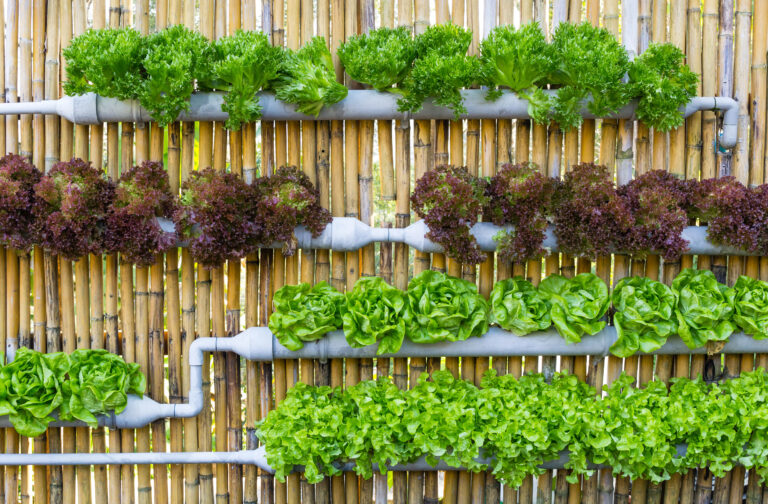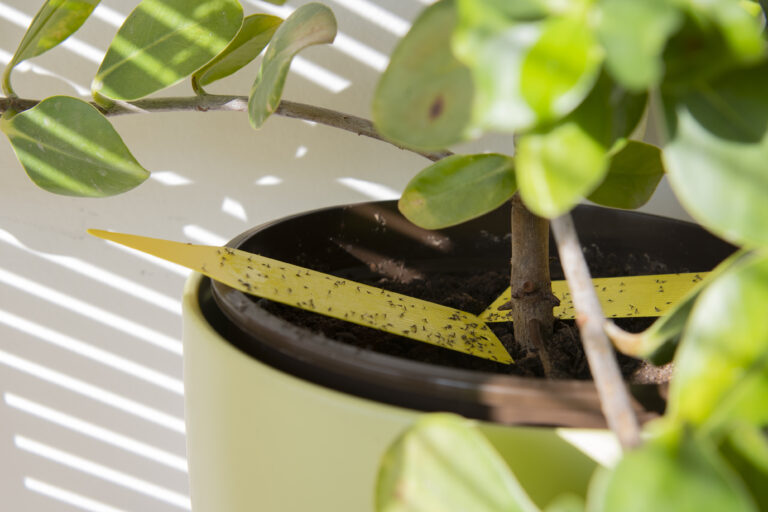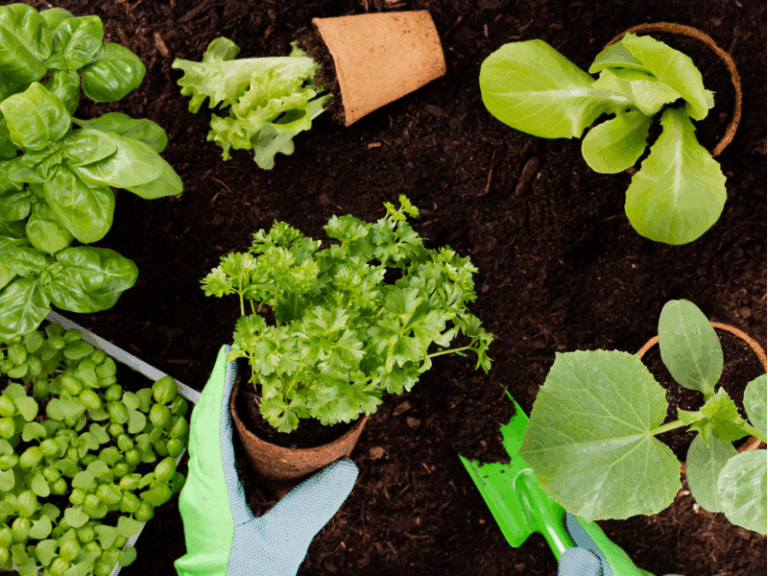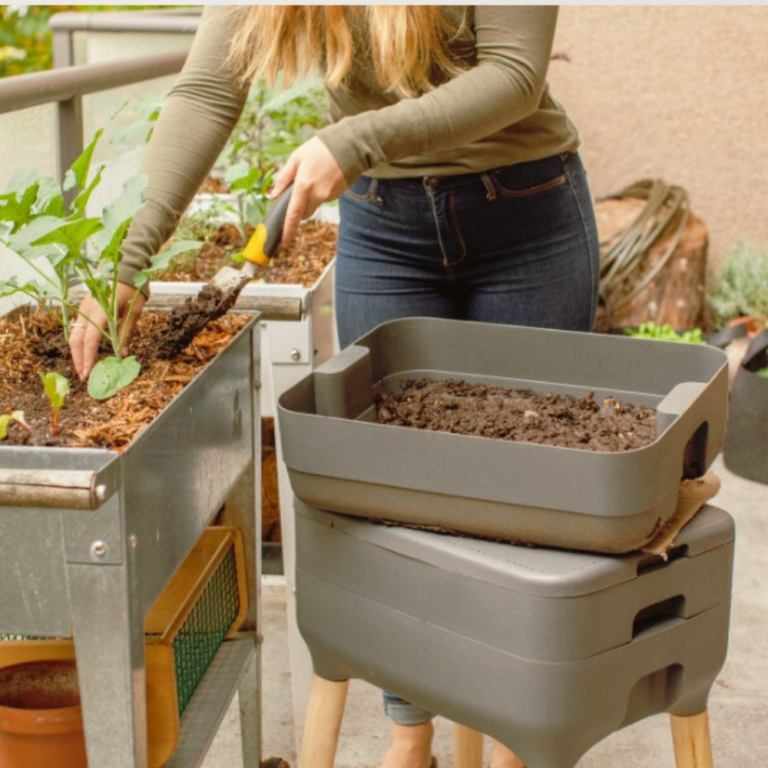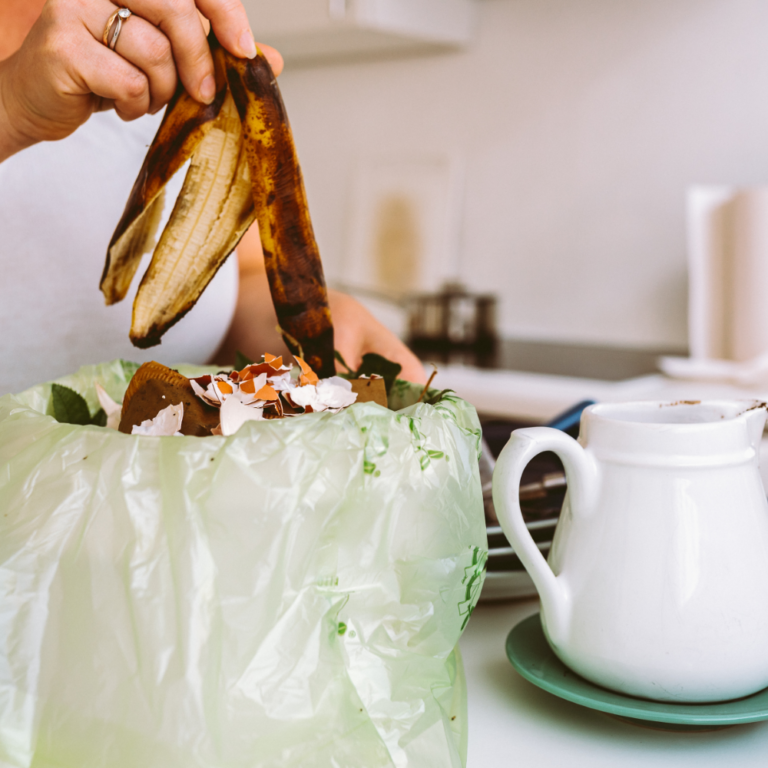Did you know that approximately 25 million tons of household waste in the United States are composted yearly? This staggering statistic from the EPA represents about 32.1% of the total municipal solid waste generated. It’s a testament to the power of composting as a sustainable practice that reduces the burden on landfills and contributes to a healthier environment. In this post, we’re exploring the world of DIY compost spreading—a practice that aligns perfectly with the ethos of sustainability and responsible stewardship of our planet. From understanding the basics of composting to building your own simple yet effective spreader, we’ll guide you through seven straightforward steps to help you build do a DIY compost spreader.
What is Compost?
Compost is a natural process that transforms organic materials into a nutrient-rich soil amendment or mulch, taking your garden to the next level. Embracing composting enhances your gardening by providing nutrient-rich soil, fostering robust plant growth, and minimizing waste. This sustainable practice enriches ecosystems, reduces reliance on synthetic fertilizers, and curtails greenhouse gas emissions. Embrace composting to elevate your gardening journey, nurturing healthier landscapes and a deeper connection with nature. Here’s how it works:
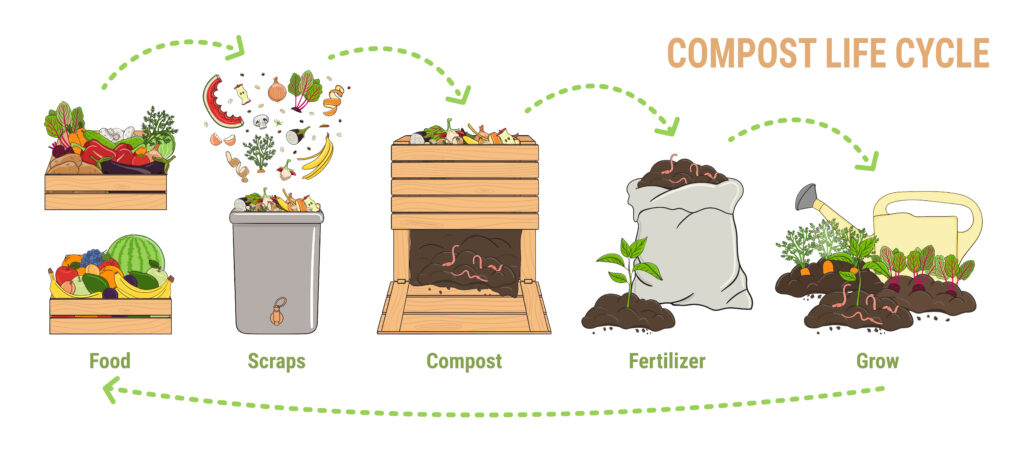
Ingredients for Composting
- Carbon-rich materials (browns) include dry leaves, straw, and shredded paper.
- Nitrogen-rich materials (“greens”): These consist of food scraps (like fruit peels and coffee grounds) and fresh yard trimmings.
- Water (moisture): Adequate moisture is essential for composting.
How Composting Happens
- Microorganisms (such as bacteria and fungi) feed on the materials in the compost pile.
- They use carbon and nitrogen to grow, water to digest materials, and oxygen to breathe.
- Over time, these microorganisms break down the organic matter, resulting in compost.
Why Compost at Home?
- Composting reduces waste sent to landfills and prevents greenhouse gas emissions.
- Compost enriches soil, enhances plant growth, and conserves water.
- It’s an inexpensive way to create high-quality soil amendment.
- Composting involves minimal effort and can be rewarding.

The impact of greenhouse gases on our planet is extensive, affecting ecosystems, societies, and the global economy. Reducing greenhouse gas emissions and adapting to a changing climate is crucial to ensure the well-being of current and future generations. According to a United Nations Environment Programme (UNEP) report on food waste, approximately 8-10% of global greenhouse gas emissions stem from food loss and waste. This figure, cited from the UNEP Food Waste Index Report 2021, underscores the significance of addressing food waste in combatting climate change. To put this into perspective, consider that the global transportation sector—cars, trucks, planes, trains, ships, and freight—contributes nearly 30% of all global warming emissions. Implementing measures such as composting to minimize food waste can substantially reduce greenhouse gas emissions and mitigate climate change.
Understanding Compost Spreaders
Before you start your DIY compost spreader project let’s take a look at some of the common types of spreaders. Compost spreaders are essential tools in gardening, facilitating the even and efficient distribution of compost across garden beds. Compost spreaders offer several advantages in gardening, including ensuring even distribution of compost, providing adjustable settings for precise application, and preventing over- or under-fertilization. Additionally, they contribute to sustainability by repurposing organic waste into nutrient-rich compost.
Common Types of Spreaders
Broadcast Spreaders
- Description: Cylindrical spreaders roll over lawns, distributing compost while capturing larger pieces for further breakdown.
- DIY Feasibility: Easy
- Materials Needed: Plywood, wire mesh, PVC pipes.
Lawn Compost Spreaders
- Description: Designed for lawns, providing precise application of compost, manure, and other garden products.
- DIY Feasibility: Easy
- Materials Needed: Wood, wire mesh, PVC pipes.
Drop Spreaders
- Description: Release compost directly beneath in a controlled manner, ideal for precise application in smaller areas.
- DIY Feasibility: Moderate
- Materials Needed: Wood, hinges, mechanism for drop rate control.
Handheld Spreaders
- Description: Portable spreaders for spot treatments or small garden beds, operated by turning a crank.
- DIY Feasibility: Challenging
- Materials Needed: Lightweight materials like plastic, metal, and crank mechanisms.
Tow-Behind Spreaders
- Description: Attachable to lawn tractors or ATVs, efficiently cover larger areas such as lawns or fields.
- DIY Feasibility: Challenging
- Materials Needed: Sturdy construction materials, welding skills, and access to metalworking tools.
Peat Moss Spreader
- Description: A peat moss spreader is a gardening tool designed to distribute peat moss evenly across your garden beds or lawns.
- DIY Feasibility: Moderate
- Materials Needed: Lightweight materials like plastic or metal for the hopper—a crank mechanism for manual operation.
Manure Spreader
- Description: Manure Spreader is designed to evenly distribute a mixture of composted manure and other organic materials across your garden beds or lawns.
- DIY Feasibility: Challenging
- Materials Needed: Wood, plastic, hinges, spread rate control mechanism (e.g., crank or rotary spreader mechanism), bolts or screws, optional wheels, manure, and compost mix.
Planning Your DIY Compost Spreader Project
Thorough planning is essential before embarking on your DIY compost spreader project. Start by gathering the necessary tools and materials, focusing on selecting composite materials known for their durability and eco-friendliness. Consideration should be given to the scale of the spreader, particularly for more extensive gardens, and ergonomic design should be prioritized for ease of handling. Additionally, safety instructions should be incorporated to promote accident prevention and uphold responsible equipment operation practices.

7 Step-by-Step Guide to Building a Compost Spreader
Building a Broadcast Spreader and Lawn Compost Spreader are two of the simpler styles of compost spreaders to construct. Below are the materials and step-by-step instructions to guide you through building both types:
Building a Broadcast Spreader
Materials Needed:
- 4 by 2 ft plywood or MDF (preferably 1/2 inch thick)
- 4 PVC 90° elbows (1/2 inch) for the frame
- A 10 ft PVC pipe for the central axle
- Staples for securing the wire gauge
- A 33 ft long cage wire (1 by 1/2 inch mesh) to overlay the frame
- Three 2 by 2 inches wood planks, each 30 inches long, for agitating the compost.
- Wood screws, a staple gun, and a drill
Step-by-Step Construction
Step 1: Cut the Circles: Mark out two circles on the plywood with a 10 ft radius and cut them. These circles will form the wheels of your broadcast spreader. The two plywood wheels should be 1 inch thick each (totaling 2 inches).
Step 2: Cut the Agitators: Prepare three wood planks, each 30 inches long. These planks will agitate the compost as the spreader turns and act as support frames.
Step 3: Set Up the Frame
- Mark three points on the circumference of each wheel, creating 120° angles from the center. You can use a protractor or print an image to guide you.
- Drill screw holes at these marked points, approximately 2 1/2 inches from the wheels’ circumference.
- Attach the three wood planks to one of the wheels using wood screws.
- Fit the second wheel on the other side of the wood planks (you may need an extra hand for this).
- Ensure the frame can roll freely on the floor.
Step 4: Fit the Wire Gauge
- Overlay a 33-foot cage wire on the frame. Leave a margin of one inch on each side.
- Staple the wire gauge around the wheels, ensuring it’s well stretched and fastened to prevent compost leakage.
Step 5: Fit the PVC Pipes
- Drill a hole at the center of each wheel where the PVC pipe will pass through.
- Cut the PVC pipe to the desired length and fix it through the holes.
- Glue the PVC elbows to the ends of the pipe.
Step 6: Fit the Handle: Attach a handle to the frame for easy maneuverability.
Step 7: Cut the Door: Create an opening in the frame to allow compost to flow out. This will serve as the “door” for spreading.
Building a Lawn Compost Spreader
Materials Needed:
Similar materials are used as the broadcast spreader, but the dimensions are adjusted to suit lawn applications.
Step-by-Step Construction:
Follow the same steps as for the broadcast spreader, but consider the following modifications:
- Use smaller dimensions for the wheels and frame to make it more suitable for lawn use.
- Adjust the wire gauge size to match the more petite frame.
- Ensure the handle is comfortable for pushing across the lawn.
Test your lawn compost spreader by filling it with compost and pushing it over your lawn. Adjust the door opening and handle height as needed.
Modifying Existing Tools for Compost Spreading
There are various ways to get creative when it comes to spreading compost, such as adapting existing tools to make the process more efficient. Here are some ideas:
Broadcast Spreader Modifications:
- Rotary Spreaders: Ideal for clumpy materials like peat moss, rotary spreaders effectively handle larger debris.
- Drop Spreaders: Drop spreaders offer precise distribution for compost pellets or delicate materials. Adjust the drop rate to control the spread.
- Hand-Held Broadcast Spreaders: These are perfect for dry materials, being lightweight and easy to maneuver.
- Compost Blower: A compost blower can quickly distribute compost if you have a larger area.
Compost Roller Spreader:
- This tool can be manually pushed or pulled by a long handle.
- The mesh openings in the 24-inch-wide drum allow for even compost distribution.
Levelawn Tool:
- The Rocklin Industry Levelawn Tool is specifically designed to spread compost evenly.
- Its 48″ x 10″ ground plate ensures easy mobility, and the stainless-steel head provides a secure grip.
- Whether turning your compost pile or revitalizing a barren patch of soil, the Levelawn has you covered.
Compost Spreader Efficiency Tips
Here are some compost spreader efficiency tips to maximize the effectiveness of your composting efforts:
Even Application: To spread the compost evenly, ensure an even distribution of compost across your lawn or garden beds. Work methodically in parallel lines, slightly overlapping each pass to guarantee comprehensive coverage without leaving any areas untreated.
Check Coverage: Regularly inspect the lawn surface to confirm the uniform distribution of compost. Adjust your spreader settings to maintain consistent coverage throughout the application process.
Break Up Large Pieces: Before using the spreader, ensure that large pieces of compost are broken down into smaller particles. This facilitates even spreading and enhances nutrient distribution across the soil.
Calibrate Your Spreader: Before applying compost, calibrate your spreader to ensure accurate distribution. Set the spreader to the appropriate rate for your specific type of compost to prevent over- or under-application.
Incorporate Compost into Soil: Consider incorporating compost into the soil when seeding a new lawn for optimal results. Till in a 1-to-2-inch layer of compost to enrich the soil and promote healthy plant growth.
Clean After Use: After each use, thoroughly clean the spreader to prevent materials from clogging the mesh or door opening. Proper cleaning ensures smooth operation and prolongs the spreader’s lifespan.
Storage: When not in use, store the spreader in a dry, covered area to prevent rusting and prolong its lifespan. Proper storage also helps maintain the spreader’s integrity for future composting tasks.
Frequently Asked Questions
Can a broadcast spreader be used to spread peat moss? Yes, a broadcast spreader can be used to spread peat moss. However, adjusting the spreader settings is essential to ensure proper distribution and prevent clogs. Peat moss is lightweight and may require a lower spreading rate than heavier materials like compost or manure.
What safety instructions should I follow when operating garden equipment? When operating garden equipment, it’s essential to prioritize safety. Start by reading the manufacturer’s instructions and familiarizing yourself with the equipment before use. Wear protective gear, such as gloves, goggles, and sturdy footwear, to prevent injuries. Ensure that the equipment is in good working condition and properly maintained. Use caution when handling sharp or rotating parts, and keep hands and clothing away from moving components. Avoid operating equipment in wet or slippery conditions to reduce the risk of accidents. Lastly, proper lifting techniques should be followed to avoid strain or injury when handling heavy equipment or materials.
How do different methods of compost spread affect soil health? Different methods of compost spreading can affect soil health in various ways. Broadcast spreading ensures even distribution of compost across the soil surface, improving soil structure, moisture retention, and nutrient availability. Tilling compost into the soil promotes better nutrient distribution and microbial activity, improving soil fertility and plant growth. Topdressing with compost replenishes nutrients and organic matter in the soil, enhancing soil health without disturbing soil structure. Compost as mulch helps conserve soil moisture, suppress weed growth, and gradually release nutrients into the soil, contributing to overall soil health and plant vitality.
This post was about 7 Simple Steps to Build Your DIY Compost Spreader.
